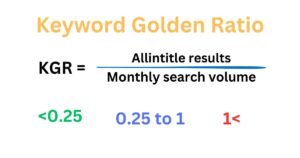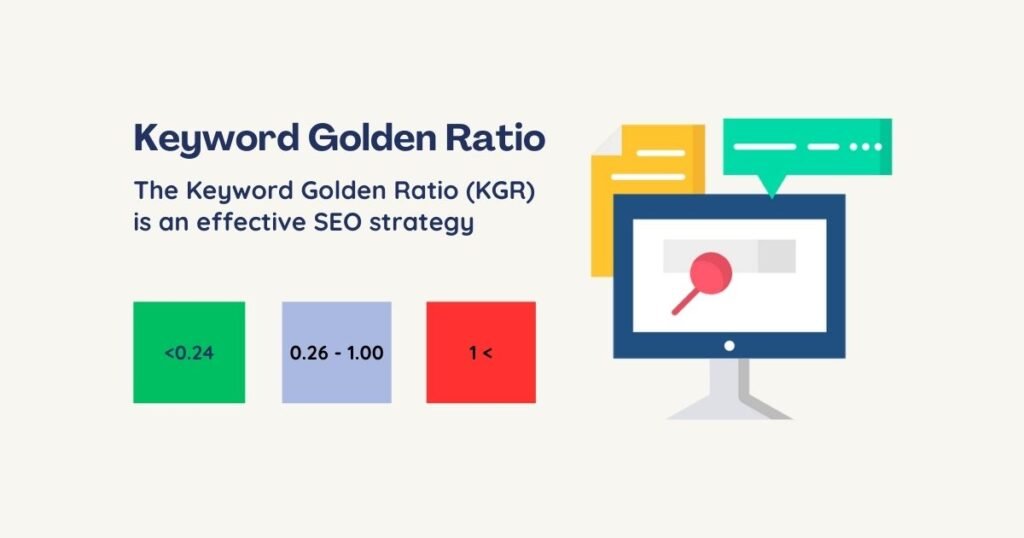What is the Keyword Golden Ratio (KGR)?
The Keyword Golden Ratio (KGR) is an effective SEO strategy that helps identify low-competition keywords with potential for high search volume. Developed by Doug Cunnington, KGR uses a simple formula: divide the number of search results with the keyword in the title by the keyword’s monthly search volume. A KGR value below 0.25 indicates a favorable opportunity for ranking. This method is particularly useful for niche targeting, allowing professionals to attract qualified traffic. By focusing on KGR keywords, content creators can improve their chances of appearing on the first page of search results. Overall, implementing KGR enhances visibility and drives organic traffic, making it a valuable tool for technical professionals in SEO.
Keyword golden ratio composed of the following components:
- Keyword Search Volume
- Allintitle Results
- KGR Formula
- Threshold Value
- Niche Focus
- Content Quality
- On-Page Optimization
- Backlink Strategy
Benefits of using Keyword golden ratio in SEO:
- Increased Ranking Potential
- Targeted Traffic Acquisition
- Cost-Effective SEO Strategy
- Improved Content Relevance
- Enhanced Niche Visibility
- Higher Click-Through Rates
- Sustainable Organic Growth
- Focus on Quality Content
- Competitive Advantage
- Flexibility in Keyword Targeting
Sample KGR keyword research table:
| Keyword | Monthly Search Volume | Allintitle Results | KGR (Allintitle/Volume) | Remarks |
| “digital marketing tips for small businesses” | 100 | 10 | 0.1 | Ideal for quick ranking |
| “benefits of digital marketing for startups” | 70 | 5 | 0.07 | Low competition, good for blog content |
| “how to create a digital marketing strategy” | 200 | 30 | 0.15 | Strong candidate, moderate search volume |
| “email marketing tips for digital marketers” | 150 | 20 | 0.13 | Relevant for niche within digital marketing |
| “social media strategies for digital marketing” | 90 | 25 | 0.28 | Slightly high but still actionable |
| “digital marketing trends for 2024” | 120 | 15 | 0.125 | Timely content for trends |
| “content marketing ideas for beginners” | 80 | 8 | 0.1 | Low competition, beginner-friendly |
| “importance of SEO in digital marketing” | 110 | 25 | 0.23 | Higher search intent, relevant to SEO |
| “best tools for digital marketing analytics” | 50 | 5 | 0.1 | Strong for product/tool reviews |
| “digital marketing on a budget” | 60 | 6 | 0.1 | Perfect for budget-conscious businesses |
Keyword Golden Ratio Formula:

- Identify a target keyword
- Find the “Allintitle” results for the keyword
- Determine the monthly search volume
- Apply the KGR formula: KGR = Allintitle results / Monthly search volume
- Aim for a KGR below 0.25 for best results
- Adjust strategy based on KGR value
Why is the KGR important for SEO?
- Identifies Low-Competition Keywords
- Enhances Search Ranking Potential
- Boosts Organic Traffic
- Supports Niche Targeting
- Increases Content Visibility
- Improves ROI on SEO Efforts
- Promotes Effective Keyword Strategy
- Reduces Time to Rank
- Strengthens SEO Content Quality
- Provides a Competitive Edge
Good KGR value for SEO:
- KGR below 0.25: Ideal, high-ranking potential
- KGR between 0.25 – 1.0: Moderate ranking potential
- KGR above 1.0: High competition, lower ranking chance
- KGR close to zero: Best for quick ranking
| KGR Value | Classification |
| 0.00 – 0.25 | Excellent |
| 0.26 – 0.75 | Good |
| 0.76 – 1.00 | Fair |
| 1.01 and above | High Competition |
How do you find the number of Google search results for a keyword?
- Enter the keyword in Google’s search bar
- Review the results count below the search bar
- Use quotes around the keyword for exact match results
- Add “allintitle:” before the keyword for title-specific results
- Utilize Google Keyword Planner for broader metrics
- Leverage SEO tools like Ahrefs or SEMrush for precise data
- Check Google’s bottom page suggestions for related results
- Filter by location or language if needed
What tools can help with KGR calculations?
- Keyword Golden Ratio Calculator Tool
- Google Keyword Planner
- Ahrefs
- SEMrush
- Keywords Everywhere
- Moz Keyword Explorer
- Ubersuggest
- Long Tail Pro
- Mangools (KWFinder)
- SERPChecker
- Keyword Surfer
To enhance performance, try using Keyword Discovery tool
Can the KGR be used for any niche?
Yes, the Keyword Golden Ratio (KGR) can be adapted for almost any niche. KGR is a data-driven SEO strategy that focuses on finding low-competition keywords with a precise search volume. By targeting keywords with a Keyword Golden Ratio (KGR) score below 0.25, professionals can identify terms that are overlooked by larger competitors, creating an opportunity for high-ranking, quick-win content.
- Adaptable across various niches
- Effective for low-competition keywords
- Ideal for niche markets with specific queries
- Useful in less saturated topics
- Supports long-tail keyword strategies
- Enhances ranking in emerging niches
- Works well in content-driven industries
- Valuable in highly competitive fields with tailored terms
- Offers flexibility in industry-specific keywords
- Provides insights for niche-focused content
How often should you check the KGR?
- Monthly for performance evaluation
- After significant content updates
- When launching new keyword-focused content
- Quarterly to assess keyword trends
- Following algorithm updates from search engines
- Whenever traffic patterns shift dramatically
- Annually for overall strategy reassessment
- Before major SEO campaigns or initiatives
- When exploring new niches or topics
- As needed based on competitor analysis
What are the limitations of using the KGR?
- Low Search Volume
- Limited Traffic Potential
- Market Saturation Challenges
- Time-Consuming Research Process
- Variability in Results
- Dependence on Accurate Data
- Possible Algorithm Changes
- Potentially Narrow Focus
- High Competition in Certain Niches
- Requires Ongoing Monitoring
How to increase keyword rankings?
- Conduct thorough keyword research.
- Calculate the KGR for potential keywords.
- Focus on long-tail variations of keywords.
- Create high-quality, valuable content.
- Optimize on-page elements effectively.
- Use relevant headers and subheadings.
- Incorporate multimedia elements for engagement.
- Build quality backlinks to your content.
- Promote content through social media channels.
- Monitor performance and adjust strategies accordingly.
Is the KGR a one-time analysis?
- KGR analysis should be ongoing.
- Search trends can change over time.
- Competitors may adjust their strategies.
- Keyword effectiveness can fluctuate.
- Regular updates help maintain relevance.
- Content performance should be monitored.
- New keywords may emerge in your niche.
- User search intent can evolve.
- SEO algorithms are constantly updated.
- Continuous analysis ensures better results.
How does the KGR relate to long-tail keywords?
- Focus on Specificity
- Lower Competition
- Higher Conversion Rates
- More Relevant to User Intent
- Enhanced Search Visibility
- Greater Opportunity for Ranking
- Easier to Optimize
- Supports Niche Targeting
- Facilitates Content Creation
- Improves Long-Term SEO Strategy
Does SEO generate traffic?
- No absolute guarantee of traffic
- Depends on search volume accuracy
- Subject to competition changes
- Requires ongoing content optimization
- Influenced by search engine algorithms
- User intent impacts effectiveness
- Quality of content matters significantly
- Backlink strategy affects visibility
- May lead to traffic over time
- KGR is a strategy, not a solution
What is the working form of KGR strategy?
- Identify Low-Competition Keywords
- Align with Content Marketing Goals
- Integrate into Keyword Research Process
- Enhance On-Page SEO Techniques
- Improve User Engagement Metrics
- Foster Content Quality and Relevance
- Build Backlinks Strategically
- Monitor Performance Regularly
- Adjust Strategy Based on Analytics
- Support Long-Term Growth Objectives
What to do if zero results for KGR keywords?
- Broaden Your Keyword Scope
- Use Synonyms and Related Terms
- Explore Long-Tail Variations
- Analyze Competitor Keywords
- Utilize Keyword Research Tools
- Investigate Niche Forums and Communities
- Check Social Media Trends
- Focus on User Intent
- Experiment with Different Topics
- Review Existing Content for Optimization
What is the role of search volume in keyword research?
- Determines Keyword Potential
- Influences Competition Levels
- Affects Traffic Volume
- Impacts Ranking Feasibility
- Guides Content Strategy
- Shapes Audience Targeting
- Balances KGR Calculation
- Indicates Market Demand
- Assists in Prioritizing Keywords
- Reflects Seasonal Trends
What is the KGR technique for keyword research?
- Blog Posts
- How-To Guides
- Product Reviews
- Listicles
- FAQs
- Case Studies
- Resource Pages
- Tutorials
- Infographics
- Comparison Articles
How do you determine the search intent of a keyword?
- Analyze the Keyword’s Language
- Review Search Engine Results Pages (SERPs)
- Evaluate Top-Ranking Content
- Identify Common Questions and Topics
- Look for Content Formats (e.g., articles, videos)
- Assess User Engagement Metrics
- Use Keyword Research Tools
- Check Related Searches and Suggestions
- Consider User Demographics and Behavior
- Monitor Social Media Discussions
Should KGR keywords be targeted individually or in clusters?
| Individual Targeting | Cluster Targeting |
| Allows for focused optimization on one keyword | Enables broader topic coverage through related keywords |
| Provides clarity in creating specific, keyword-focused content | Encourages creating multiple pieces that interlink and cover a topic comprehensively |
| Limited to single keyword authority | Enhances topical authority by covering all aspects of a topic |
| Easier to track performance on individual keywords | May require more complex tracking across multiple keywords |
| Limited engagement due to single-focus content | Increases engagement by offering additional related content |
| Reduces competition by focusing on specific keywords | May face higher competition but can rank collectively on multiple keywords |
| Targets specific user queries | Addresses a range of user intents comprehensively |
| Allows for highly tailored, specific content strategies | Benefits from interlinked content that builds authority and relevance |
| Simplifies targeting but has narrow SEO gains | Leverages keyword relationships, improving overall SEO value |
How do changes in competition impact the KGR over time?
- Evolving Market Dynamics
- Fluctuating Search Trends
- New Competitors Entering the Field
- Changes in Content Quality
- Algorithm Updates Affecting Rankings
- Shifts in User Intent and Behavior
- Increased Content Saturation
- Impact on Keyword Value
- Necessity for Ongoing Keyword Research
- Adaptation of SEO Strategies
The Keyword Golden Ratio (KGR) is a practical SEO technique for finding low-competition keywords with a high chance of ranking. This approach helps content creators identify specific keywords overlooked by competitors, which can quickly rank on search engines. Professionals who implement KGR effectively can drive relevant traffic, increase visibility, and improve SEO performance. Using KGR allows websites to focus on specific queries, boosting organic growth and engagement.

